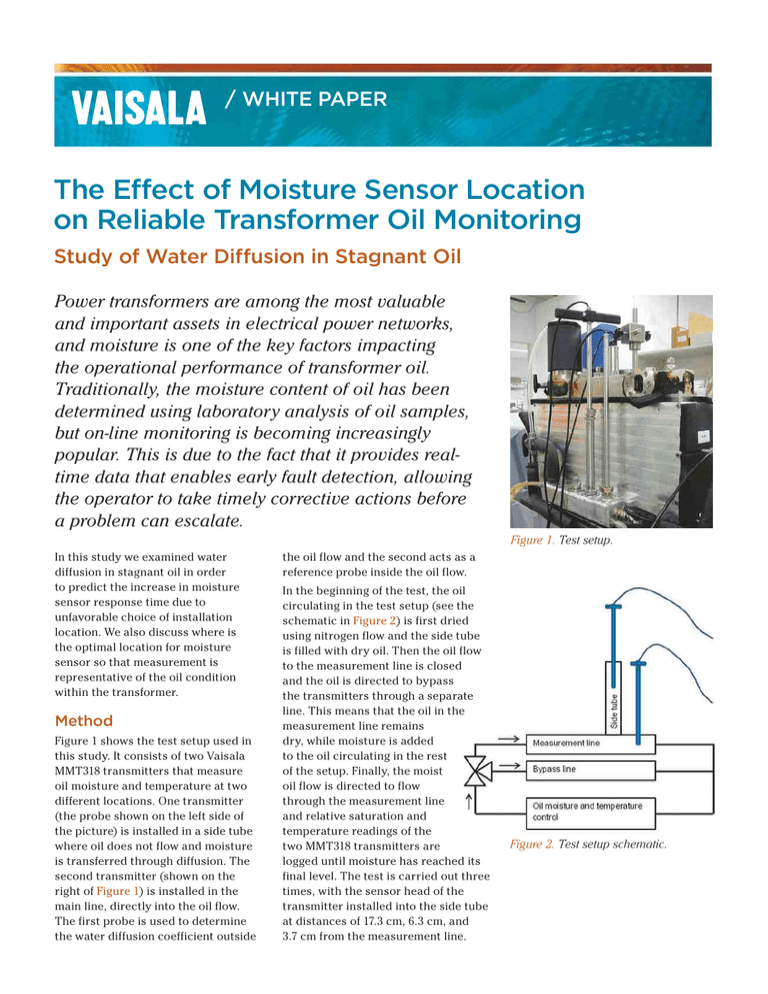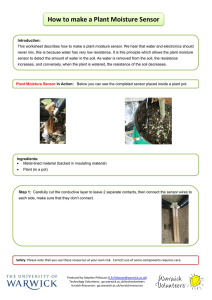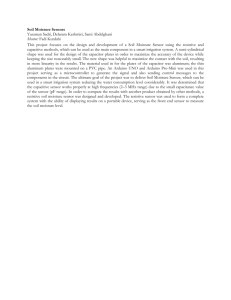
/ WHITE PAPER
The Effect of Moisture Sensor Location
on Reliable Transformer Oil Monitoring
Study of Water Diffusion in Stagnant Oil
Power transformers are among the most valuable
and important assets in electrical power networks,
and moisture is one of the key factors impacting
the operational performance of transformer oil.
Traditionally, the moisture content of oil has been
determined using laboratory analysis of oil samples,
but on-line monitoring is becoming increasingly
popular. This is due to the fact that it provides realtime data that enables early fault detection, allowing
the operator to take timely corrective actions before
a problem can escalate.
Figure 1. Test setup.
In this study we examined water
diffusion in stagnant oil in order
to predict the increase in moisture
sensor response time due to
unfavorable choice of installation
location. We also discuss where is
the optimal location for moisture
sensor so that measurement is
representative of the oil condition
within the transformer.
Method
Figure 1 shows the test setup used in
this study. It consists of two Vaisala
MMT318 transmitters that measure
oil moisture and temperature at two
different locations. One transmitter
(the probe shown on the left side of
the picture) is installed in a side tube
where oil does not flow and moisture
is transferred through diffusion. The
second transmitter (shown on the
right of Figure 1) is installed in the
main line, directly into the oil flow.
The first probe is used to determine
the water diffusion coefficient outside
the oil flow and the second acts as a
reference probe inside the oil flow.
In the beginning of the test, the oil
circulating in the test setup (see the
schematic in Figure 2) is first dried
using nitrogen flow and the side tube
is filled with dry oil. Then the oil flow
to the measurement line is closed
and the oil is directed to bypass
the transmitters through a separate
line. This means that the oil in the
measurement line remains
dry, while moisture is added
to the oil circulating in the rest
of the setup. Finally, the moist
oil flow is directed to flow
through the measurement line
and relative saturation and
temperature readings of the
two MMT318 transmitters are
logged until moisture has reached its
final level. The test is carried out three
times, with the sensor head of the
transmitter installed into the side tube
at distances of 17.3 cm, 6.3 cm, and
3.7 cm from the measurement line.
Figure 2. Test setup schematic.
Findings
The relative saturations measured
by the two transmitters located in
the side tube (RSdiff ) and in the oil
flow (RSref ), as well as a curve fitted
to RSdiff (named RSfit), are shown in
Figures 3 to 5 for the three test runs
described above. Figure 3 shows
the results of the test run where
the sensor is located at a distance
of 17.3 cm from the oil flow, while
Figures 4 and 5 show the results
for the distances of 6.3 and 3.7 cm
respectively. When examining RSref,
it can be seen that the readings
increase slowly at first and then
more rapidly. The slow increase
corresponds with the situation where
the oil flow to the measurement line
is closed and moisture is added to
the oil circulating through the rest
of the setup. This small leakage
does not have any bearing on the
conclusions of this study. The rapid
change in RSref begins when the moist
oil flow is again directed through the
measurement line. The fitted curve
RSfit is given by the equation
RSfit(t) = (RSmax –RS0) (1–e-(t-t0)/τ) + RS0 (1)
where RSmax and RS0 are the final
and initial relative saturation levels,
respectively, t0 is the time lag during
which the moist oil is directed
through the measurement line but
diffused water is not yet detected in
the side tube, and τ is the response
time constant. Table 1 summarizes
the parameters of best fits of
Equation (1) to the measured data.
Figure 3. Relative saturation in the measurement line (RSref) and in the side tube
(RSdiff), and best fit of Equation 1 to RSdiff (named RSfit). Distance from sensor head
to oil flow is 17.3 cm.
Figure 4. Relative saturation in the measurement line (RSref) and in the side tube
(RSdiff), and best fit of Equation 1 to RSdiff (named RSfit). Distance from sensor head
to oil flow is 6.3 cm.
The diffusion coefficient D, when
assumed constant, is given by the
equation
X2
D= ,
(2)
6t0
where X is the diffusion length and t0
is the diffusion time lag [1,2]. Using
Equation (2) and the distance and
time lag data from Table 1 yields
a consistent value of
D = (1.4 ± 0.2) · 10 -4 cm2/s.
Figure 5. Relative saturation in the measurement line (RSref) and in the side tube
(RSdiff), and best fit of Equation 1 to RSdiff (named RSfit). Distance from sensor head
to oil flow is 3.7 cm.
The tests carried out in this study
demonstrate that the response time
of a moisture sensor located in a side
tube outside the oil flow increases
rapidly as the distance of the sensor
from the oil flow is increased. When
examining Table 1 and Figure 6 it can
be seen that a distance of just a few
centimeters (3 to 6 cm) corresponds
to a response time constant of
several days (3 to 5 days), which is
impractical from the viewpoint of
moisture measurement. The diffusion
time lag must also be taken into
account, as this also increases as
the sensor distance from the oil flow
is increased (see Figure 7), further
extending the response time of
moisture measurement.
Distance from
oil flow (cm)
Diffusion time
lag t0 (d)
Response time
constant τ (d)
Diffusion
coefficient D
(cm2/s)
17.3
4.6
45
1.3 · 10-4
6.3
0.5
5.1
1.5 · 10-4
3.7
0.2
3.6
1.3 · 10-4
Table 1. Summary of test results.
Study demonstrates that the
response time of a moisture sensor
located in a side tube outside the
oil flow increases rapidly as the
distance of the sensor from the oil
flow is increased. A distance of
just a few centimeters (3 to 6 cm)
corresponds to a response time
constant of several days.
Figure 6. Response time constant τ versus moisture sensor distance from oil flow.
Figure 7. Diffusion time lag t0 versus moisture sensor distance from oil flow.
Conclusions – Location
the Key to Accurate
Measurement
The results of this study show that
the response time is very long in
stagnant oil. Furthermore, it is
uncertain whether the relative
saturation at the sensor level will
ever reach the relative saturation of
the flowing oil. Therefore, it is clear
that the moisture sensor should
be placed directly into the oil flow.
This provides direct contact with oil
that is truly representative of the oil
condition within the transformer.
The oil cooling circulation line of a
transformer provides an installation
location where true oil exchange
is present and where the oil flow
significantly reduces the sensor’s
response time, meaning that the
measured values are representative
and provided in real time. Where
installation to optimal location is not
possible, it is strongly recommended
to minimize the distance between
the sensor and the oil flow. The
sensor should not be located at
the bottom of the transformer tank
unless it is evident that there is true
oil exchange present – the lack of oil
flow at the bottom of the tank may
mean that the sensor is measuring
still sludge and not the actual state of
the transformer oil.
Figure 8. Recommended installation locations for the moisture sensor. The oil
cooling circulation line (left) is the ideal location for measurement in both forced
and free circulation cooling implementations; installation through outer wall of
transformer tank (right).
Figure 9. Non-recommended installation locations for the moisture sensor. Oil
sample connector near the bottom of the transformer tank (left); expansion tank
(right).
References
1) Frisch, H. L. The time lag in diffusion. J. Phys. Chem. 1957, 61; pp. 93–95.
2) Crank, J. Methods of measurement. In: Diffusion in Polymers; J. Crank and G. S. Park, Eds.; Academic Press, New York,
1968; pp. 1–39.
Please contact us at
www.vaisala.com/requestinfo
www.vaisala.com
Ref. B211462EN-A ©Vaisala 2015
Scan the code for
more information
This material is subject to copyright protection, with all
copyrights retained by Vaisala and its individual partners. All
rights reserved. Any logos and/or product names are trademarks
of Vaisala or its individual partners. The reproduction, transfer,
distribution or storage of information contained in this brochure
in any form without the prior written consent of Vaisala is strictly
prohibited. All specifications — technical included — are subject
to change without notice.




